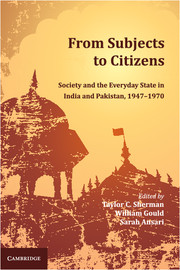Book contents
- Frontmatter
- Contents
- Acknowledgements
- Introduction
- 1 Personal Law and Citizenship in India's Transition to Independence
- 2 From Subjects to Citizens? Rationing, Refugees and the Publicity of Corruption over Independece in UP
- 3 Performing Peace: Gandhi's Assassination as a Critical Moment in the Consolidation of the Nehruvian State
- 4 Migration, Citizenship and Belonging in Hyderabad (Deccan), 1946–1956
- 5 Punjabi Refugees' Rehabilitation and the Indian State: Discourses, Denials and Dissonances
- 6 Sovereignty, Governmentality and Development in Ayub's Pakistan: The Case of Korangi Township
- 7 Everyday Expectations of the State during Pakistan's Early Years: Letters to the Editor, Dawn (Karachi), 1950–1953
- 8 Concrete ‘Progress’: Irrigation, Development and Modernity in Mid-Twentieth Century Sind
- 9 Partition Narratives: Displaced Trauma and Culpability among British Civil Servants in 1940s Punjab
- Contributors
- Index
8 - Concrete ‘Progress’: Irrigation, Development and Modernity in Mid-Twentieth Century Sind
Published online by Cambridge University Press: 05 February 2014
- Frontmatter
- Contents
- Acknowledgements
- Introduction
- 1 Personal Law and Citizenship in India's Transition to Independence
- 2 From Subjects to Citizens? Rationing, Refugees and the Publicity of Corruption over Independece in UP
- 3 Performing Peace: Gandhi's Assassination as a Critical Moment in the Consolidation of the Nehruvian State
- 4 Migration, Citizenship and Belonging in Hyderabad (Deccan), 1946–1956
- 5 Punjabi Refugees' Rehabilitation and the Indian State: Discourses, Denials and Dissonances
- 6 Sovereignty, Governmentality and Development in Ayub's Pakistan: The Case of Korangi Township
- 7 Everyday Expectations of the State during Pakistan's Early Years: Letters to the Editor, Dawn (Karachi), 1950–1953
- 8 Concrete ‘Progress’: Irrigation, Development and Modernity in Mid-Twentieth Century Sind
- 9 Partition Narratives: Displaced Trauma and Culpability among British Civil Servants in 1940s Punjab
- Contributors
- Index
Summary
Introduction
The idea of ‘developing’ Sind has been a lynchpin of government action and rhetoric in the province during the twentieth century. The most important single element of development during the mid-twentieth century was the massive extension and renovation of Sind's irrigation system and the corresponding increase in acreage of land available for cultivation. The central symbols of this development were three barrage dams—the Lloyd Barrage at Sukkur completed in 1932, the Kotri Barrage completed in 1955, and the Gudu Barrage completed in 1962. This paper examines the way that ideas of development and modernity were inscribed in discourses surrounding the ceremonial events connected with these projects, in order to demonstrate that the idea of imposing progress on a province considered backward by its administrators survived longer than the British regime which had introduced it. Because of the vital agricultural and economic importance of the Barrages to Sind, these ceremonies were major events, in which the harnessing of a capricious natural resource (the River Indus) signified the rulers' mastery over their territory. As such, the ceremonies provide a unique window onto the public presentation of state authority before and after Independence.
The power of ritual in locating states in relation to the peoples whom they govern is well known to the humanities. In terms of colonial India, this scholarship has considered a range of angles, from the shift from princes to nationalist leaders participating in imperial ceremonies during the twentieth-century Raj, to the tension produced by the way that ceremonies function as a performative arena for diverse interests at the same time that the hegemony of the organizer is asserted over the actors.
- Type
- Chapter
- Information
- From Subjects to CitizensSociety and the Everyday State in India and Pakistan, 1947–1970, pp. 193 - 215Publisher: Cambridge University PressPrint publication year: 2014



